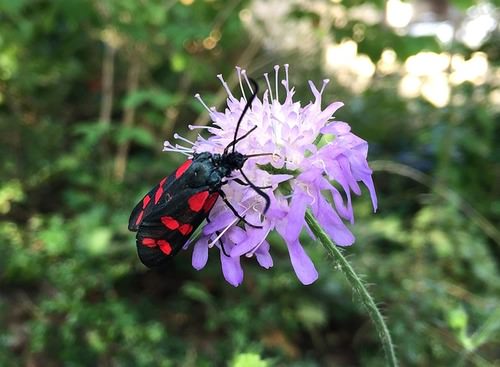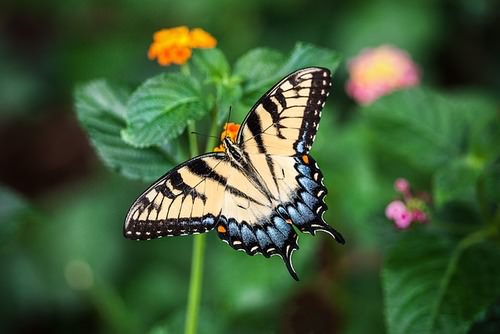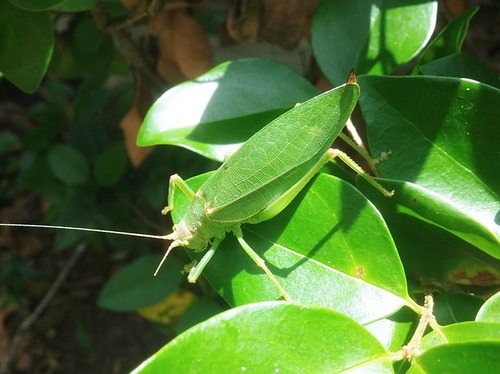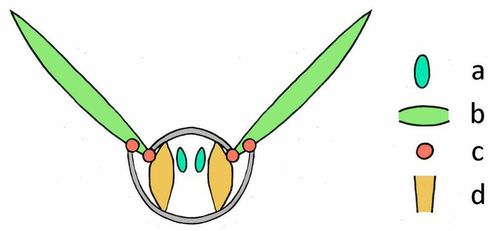15.38 昆虫飞行 -- -- 先进
章节大纲
-
What makes so successful?
::是什么使得如此成功?One characteristic that helps is the ability to fly, as shown with this ladybug. This ability helps tremendously. Why do you think flight has made these invertebrates so successful?
::一种有帮助的特征是飞行能力, 正如这只小虫所显示的那样。 这种能力非常有帮助。 为什么你认为飞行让这些无脊椎动物如此成功?A Flight Plan for Success
::成功飞行计划Insects owe much of their success to the evolution of flight. They are the only invertebrates that can fly, and the indicates that they had been enjoying the benefits of flight for over 100 million years before joined them in their aerial habitats . What are the benefits of flight? It is a guaranteed means of escape from predators that are restricted to land and . The great speeds and vast distances traveled by insects have also provided for efficient dispersal . Flying insects can easily seek new habitats and additional food sources when the need arises. And flight aids in the search for a mate. What is the overall structure of an insect wing ? How does the organism control the wings to enable flight? These questions will be answered in the remainder of this section.
::昆虫之所以成功,是因为飞行的演变。它们是唯一能够飞翔的无脊椎动物,并且表明它们在飞行超过1亿年前就已经享受飞行的好处了。飞行的好处是什么?它是来自陆地的捕食者的一种有保障的逃逸手段。昆虫的飞速和远距离也为有效散布提供了便利。飞虫很容易在需要时寻找新的栖息地和更多的食物来源。在寻找伴侣时,它们还有飞行辅助。昆虫翅膀的总体结构是什么?生物如何控制翅膀以便飞行?这些问题将在本节的其余部分回答。-
Edit here for caption
::编辑此标题 -
Edit here for caption
::编辑此标题 -
Edit here for caption
::编辑此标题
Form and Function in Insect Wings. Beetles, butterflies, and katydids all have two pairs of wings that they use for flight. However, their wings are very different because they have other functions as well. Insects generally have two pairs of wings, and they are actually part of the exoskeleton . They are formed by out-folds of the exoskeleton on the thorax during . Although wings primarily function to enable flight, some wings are structured to serve other functions as well:
::昆虫通常有两对翅膀,它们实际上是外骨骼的一部分。它们是由胸轴外骨骼外部的外部组成。虽然翅膀的主要功能是飞行,但有些翅膀的结构也是为了发挥其他功能:-
Protective body covering (beetles).
::保护体覆盖(蜂窝)。 -
Sound production (cicadas).
::音响生产(cicadas)。 -
Heat retention.
::保持热量。 -
Visual
(butterflies).
::视觉(蝴蝶)。 -
Orientation.
::方向 方向 方向 方向 方向 方向 方向 方向 方向 方向 方向 方向 方向 方向 方向 方向 方向 方向 方向 方向 方向 方向 方向 方向 方向 方向 方向 方向 方向 方向 方向 方向 方向 方向 方向 方向 方向 方向 方向 方向 方向 方向 方向 方向 方向 方向 方向 方向 方向 方向 方向 方向 方向 方向 方向 方向 方向 方向 方向 方向 方向 方向 方向 方向 方向 方向 方向 方向 方向 方向 方向 方向 方向 方向 方向 方向 方向 方向 方向 方向 方向 方向 方向 方向 方向 方向 方向 方向 方向 方向 方向 方向 方向 方向 方向 方向 方向 方向 方向 方向 方向 方向 方向 方向 方向 方向 方向 方向 方向 方向 方向 方向 方向 方向 方向 方向 方向 方向
The structure of the wings varies from the thin, paper-like flaps of butterflies to the tough, armor-like coverings of beetles. Examples of different wing types are shown in Figure .
::翅膀的结构各不相同,从蝴蝶薄薄的、纸状的扇形到坚硬的、盔甲式甲状甲状甲壳类甲虫。图中显示了不同翼型的例子。Insect wings can have very different structures that allow them to be used for purposes in addition to flight. (a) The tough wings of beetles serve as a protective covering when the animal is not flying. (b) The papery and often colorful wings of a butterfly also function as visual cues in communication. The circulatory, respiratory, and nervous systems all extend into the wings. Components of these systems, such as , trachea , and nerves , make up the veins that can be seen branching throughout the wings of with thin wing tissue . The of the wing are separated by and named after the veins. This is shown in Figure .
::循环系统、呼吸系统和神经系统都伸入翅膀。这些系统的组成部分,如气管和神经,组成了可以看见的血管,在翅膀的翅膀上以薄的翅膀组织穿插。机翼由静脉隔开并按静脉命名。图中显示了这一点。A diagram of the different cells that make up an insect wing. The labels correspond to the following cell names: C = costa, Sc = subcosta, R = radius, M = media, Cu = cubitus, and A = anal. These cells are named according to a system of insect wing nomenclature called the Comstock-Needham system. They are based on the names of the veins that separate the cells from each other. In this diagram, the veins are shown as black lines. The subscript numbers indicate cells produced by different branches of the same vein. There are two different mechanisms of insect flight: indirect flight and direct flight. These two types of flight differ in how the insect's cause the wings to flap. For direct flight, the muscles insert into the hinged base of the wing and cause the wings to flap by initiating movements in the base. This is considered an earlier version of insect flight that likely evolved before indirect flight. For insects with an indirect flight mechanism there are no muscles attached directly to the wings.
::昆虫飞行有两种不同的机制:间接飞行和直接飞行。这两种类型的飞行在昆虫如何导致翅膀折叠方面有所不同。对于直接飞行,肌肉插入翅膀的骨骼,通过在基地发动运动而使翅膀折叠。这被认为是在间接飞行之前可能出现的早期昆虫飞行。对于具有间接飞行机制的昆虫,没有直接与翅膀相连的肌肉。For indirect flight, the muscles do not attach to the wings. Instead, they attach to the walls of the thorax, as shown in Figure . Muscle contractions distort the shape of the thorax, and this in turn causes the wings to move. Recall that the wings are extensions of the thoracic exoskeleton.Some insects also use their abdomen as a sort of rudder while they fly.
::对于间接飞行,肌肉并不附着在翅膀上,相反,肌肉附着在胸部的墙壁上,如图所示。肌肉收缩扭曲了胸部的形状,这反过来又导致翅膀移动。请注意,翅膀是胸部外骨骼的延伸。有些昆虫在飞行时还把腹部用作方向舵。A diagram showing the organization of muscle attachments for indirect flight. This figure shows a cross-section of an insect that moves by indirect flight. The labels are as follows: a = wings, b = joints, c = dorsoventral muscles, and d = longitudinal muscles. The combined actions of the dorsoventral and longitudinal muscles deform the shape of the thorax. This shape distortion causes to wings to move indirectly, meaning that the muscles have no direct attachments to the wings. Insects that use indirect flight generally have more fine control over their movements. They are often able to hover and fly backwards, something not usually accomplished by direct flight insects. Figure shows examples of an insect flying by a direct mechanism and an insect flying by an indirect mechanism.
::使用间接飞行的昆虫通常对它们的移动有较细的控制,它们往往能够盘旋和向后飞,这是通常不是直接飞行昆虫完成的。图中举例说明了一种昆虫通过直接机制飞行,而一种昆虫则通过间接机制飞行。A dragonfly flying by a direct mechanism (a) and a bee flying by an indirect mechanism. One difference between these two forms of flight is that in the direct mechanism the two sets of wings usually function independently of each other, whereas insects that carry out indirect flight often have fused both sets of wings so that they function together. Summary
::摘要-
Insects are the only invertebrates that can fly, and the fossil record indicates that they had been enjoying the benefits of flight for over 100 million years before reptiles joined them in their aerial habitats.
::昆虫是唯一能够飞翔的无脊椎动物,化石记录表明,在爬行动物加入其空中栖息地之前,它们已经享受了1亿多年前的飞行利益。 -
Insects generally have two pairs of wings, and they are actually part of the exoskeleton.
::昆虫通常有两对翅膀, 它们实际上是外骨骼的一部分。 -
Benefits of flight include evading predators, dispersal, and finding a mate.
::飞行的好处包括逃避掠食者、散布和寻找伴侣。 -
Other functions of wings include protection, sound production, heat retention, visual communication, and orientation.
::翅膀的其他功能包括保护、音响生产、保热、视觉通信和定向。 -
There are two different mechanisms of insect flight: indirect flight and direct flight.
::昆虫飞行有两种不同的机制:间接飞行和直接飞行。
Review
::回顾-
Which invertebrates evolved the ability to fly? Did this occur before or after vertebrates evolved the ability to fly?
::哪个无脊椎动物进化了飞行能力?这是在脊椎动物进化了飞行能力之前还是之后发生的? -
List some benefits of flight.
::列出飞行的一些好处。 -
What makes up the wings of insects?
::昆虫的翅膀是什么构成的? -
What are some other functions of insect wings excluding flight?
::昆虫翅膀除了飞行之外还有其他什么功能? -
Explain the difference between direct and indirect flight. Which one is superior, and which one evolved first?
::解释直接飞行和间接飞行之间的区别。 哪个是上等人,哪个是先进的?
-







